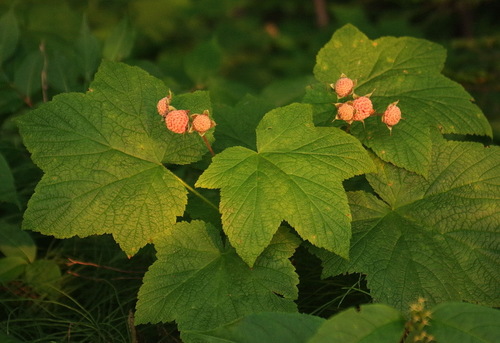|
| Common Animals Fish Mushrooms Flora |
Rubus parviflorus |
June: Fruiting begins, berries start forming.
Used by indigenous peoples for food and medicine Leaves applied for stomach issues and as a hemostatic agent
Shrub with large soft leaves resembling maple Berries are large but fall off easily when ripe
Found at forest edges, slopes, and open woods Grows as a shrub up to 2 m tall, berries are large and visible
Easy to harvest due to large size Best collected in dry weather after dew evaporates
Juicy but not long-storing — process promptly Suitable for jam, juice, drying, and freezing
Berry: Large, bright red, sweet with a mild tartness
Leaves: Used for infusions and teas, rich in tannins
Leaves: Used for infusions and teas, rich in tannins
Thimbleberry Jam (Boiling)
Thick, fragrant, rich in flavor
Thick, fragrant, rich in flavor
1. Sort and rinse berries, mash them. Measure the mass.
2. Add sugar (1:1 ratio) and boil until thickened.
3. Pour into jars and seal.
2. Add sugar (1:1 ratio) and boil until thickened.
3. Pour into jars and seal.
Thimbleberry Leaf Infusion (Infusion)
Astringent and anti-inflammatory effect
Astringent and anti-inflammatory effect
1. Pour 250 ml boiling water over 1 tbsp dried leaves.
2. Steep for 10 minutes, strain.
3. Drink 1/2 cup twice daily.
2. Steep for 10 minutes, strain.
3. Drink 1/2 cup twice daily.
Berry Drink (Mors) (Pressing and dilution)
Natural drink without heating
Natural drink without heating
1. Press juice from berries (500 ml).
2. Dilute with 1 L cold water, add honey to taste.
3. Serve chilled.
2. Dilute with 1 L cold water, add honey to taste.
3. Serve chilled.
Thimbleberry Pie (Baking)
Tender filling with rich flavor
Tender filling with rich flavor
1. Prepare shortcrust pastry, place in a baking dish.
2. Top with berries, sprinkle with sugar and starch.
3. Bake for 35–40 minutes at 180°C (350°F).
2. Top with berries, sprinkle with sugar and starch.
3. Bake for 35–40 minutes at 180°C (350°F).
 United States · Texas · Hays
United States · Texas · Hays
